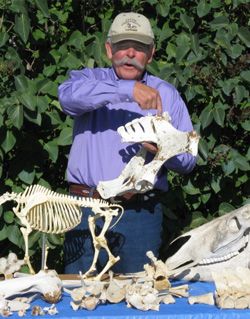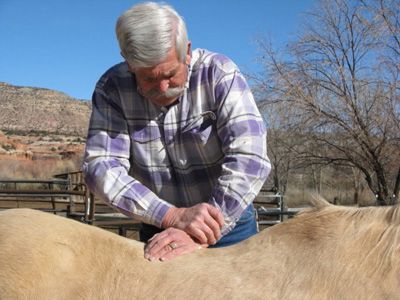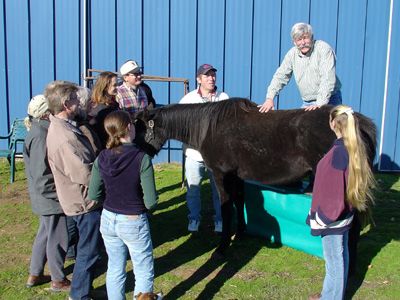Welcome to EquineSpine.com - Equine Chiropractic Educational Site
WHEN DOES MY HORSE NEED A CHIROPRACTOR?
-
 Drop in performance, speed, agility
Drop in performance, speed, agility -
Unexplained lameness
-
Problems with gait, stride, coordination, stumbling
-
Head shyness
-
Problems with lead changes
-
Refusal or hesitation to take your cues
-
Attitude problems (biting, kicking, bucking, threatening)
-
Training or behavior problems
-
Moving away during saddling or mounting
-
Stiffens when you ride
-
High/low head carriage
-
Unexplained digestive problems
-
Conditions not responding to current health care
-
Doesn’t come to you when you approach
-
Doesn’t love you anymore
HORSES DO NOT SHOW PAIN.
Horses do not show that they are in pain or that they are sick or injured, until the condition is quite advanced. By then they are suffering and may be causing permanent damage. Do not forget that horses are prey animals and herd animals. The natural predators of the herd look for the very young, the very old, or the sick or injured, because they are easier to catch and eat. While the horse cannot do anything about its age, it can hide its pain. Its very life depends on how well it hides its pain. This is in their genes. You may not know that something is wrong with your horse until it’s too late.
INJURIES HEAL WITH SCAR TISSUE AND FIBROSIS WHICH CAUSES DEGENERATION.
Fact! No injury heals 100%. There is always some scar tissue.
Horses are injury magnets. They are always getting hurt. Don't forget that they weren't designed to be ridden by humans or hauled around in trailers. These types of injuries are usually mechanical type injuries and mechanical treatment like chiropractic works well. Of course, don't ignore standard veterinary care that is also often needed for certain types of injuries.
 Horses have their own natural healing abilities, but don't forget that they are prey animals. The horse will try to patch itself up quickly with a cheaper grade of tissue resulting in scar tissue and fibrotic repair. The major killers of horses in the wild were starvation, bacterial infection, and being eaten (killed for food).
Horses have their own natural healing abilities, but don't forget that they are prey animals. The horse will try to patch itself up quickly with a cheaper grade of tissue resulting in scar tissue and fibrotic repair. The major killers of horses in the wild were starvation, bacterial infection, and being eaten (killed for food).
For survival, a quick patch type of healing (more scar tissue) was more important than an optimal healing that took much longer but would prevent degeneration. The horse was more concerned with not being someone’s dinner than it was with living a long healthy life.
SCAR TISSUE AND FIBROSIS DISTORTS THE NERVOUS SYSTEM.
Read the next section about CHIROPRACTIC to understand how the nervous system becomes distorted by the injury causing “GARBAGE IN = GARBAGE OUT.”
This will show how the neurological and biomechanical distortions of an injury and improper healing cause harm and further misery.
THE SPINE BEHAVES DIFFERENTLY THAN THE REST OF THE SKELETON.
The movements of the individual bones of the spine (vertebra) are controlled in the brain by the cerebellum, not the cortex, which is what controls the extremities and allows for voluntary movement. Horses, like humans, have voluntary control of only the large global motions of the spine such as bending to the side or flexing the whole back. They cannot voluntarily control an individual joint in the spine.
If they injure a joint in the spine, protective muscle spasms develop to stabilize the joint from further injury, but this immobilization results in the formation of fibrosis and scar tissue.
CHIROPRACTIC TO THE RESCUE.
Sports medicine, the big buzz word today, boils down to minimizing scar tissue and maximizing proper healing that allows optimal rehabilitation. This is what chiropractic is all about.
Chiropractic is the only treatment that can treat a specific spinal joint to prevent or break- up scar tissue and bring back normal motion and neurological feedback to these important joints.
up scar tissue and bring back normal motion and neurological feedback to these important joints.
Remember that if you do not correct the distorted or restricted motion it will cause abnormal biomechanics that cause a joint to wear improperly or tear itself apart. This results in degeneration the joint. The abnormal motion of the joint is also what causes distorted messages in the nervous system. Chiropractic treatment will make your horse happy and perform better.
Always consult a licensed veterinarian first before making any decisions about your pet's health.
You will be learning equine chiropractic techniques but this does not legally entitle you to adjust pets other than your own. In fact, even chiropractors, unless certified by their state, who are not veterinarians are not legally entitled to adjust animals other than their own unless given special written veterinary permission. You are advised to call your state's veterinary board for details. If you are a doctor of chiropractic, you are advised to call your chiropractic board.
The course is designed to complement and enhance the knowledge of animal practitioners and students. This is not a certification course and open to all horse enthusiasts.
